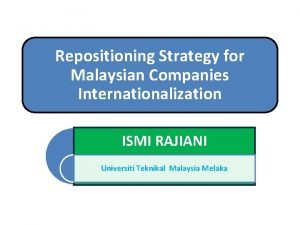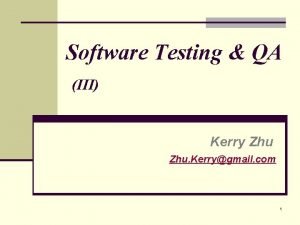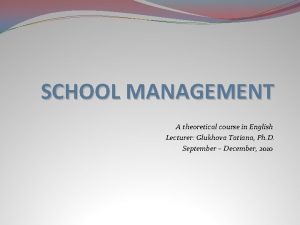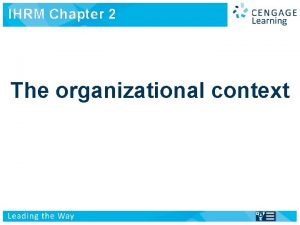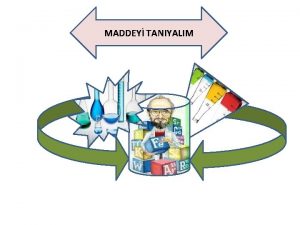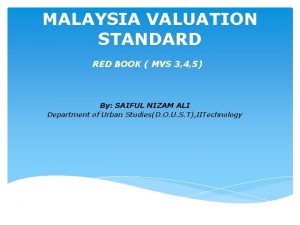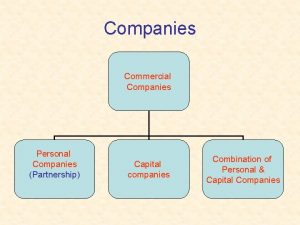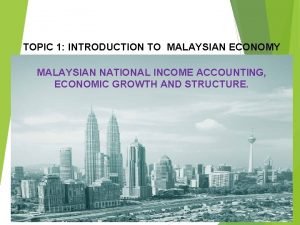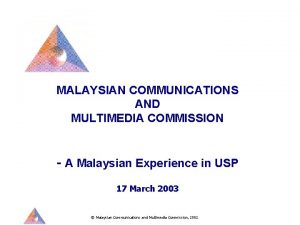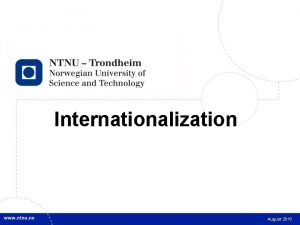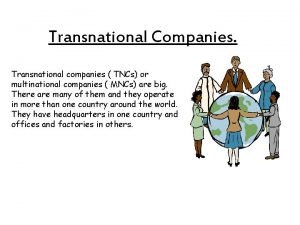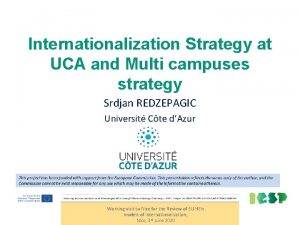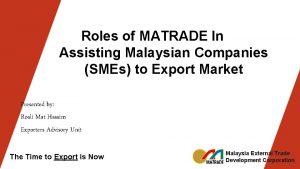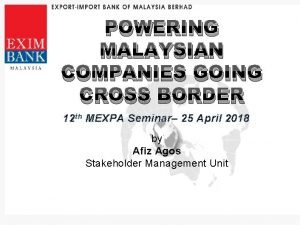Repositioning Strategy for Malaysian Companies Internationalization ISMI RAJIANI




























- Slides: 28

Repositioning Strategy for Malaysian Companies Internationalization ISMI RAJIANI Universiti Teknikal Malaysia Melaka

Malaysia in Brief Progressed socio economically Since 1957 First-class network of infrastructure that is comparable to those in developed countries strategic location in the fastest-growing region with a strong natural resource endowment

Xavier, J. A and Ahmad, Z. U. (2012). Proposed scholarly research agenda for transforming Malaysia into a model developing nation. International Journal of Public Sector Management, 25 (3), 231 – 243. Stuck in the middleincome trap Cannot compete with Vietnam and Indonesia in lower costs and labourintensive production Unable to compete with high valueadded economies

Malaysian COMPANIES Will they all adopt the Overall Cost Leadership Product Strategy co-aligning with their local competitive advantage? Going Global

Proposition 1: Malaysian exporting companies have a different initial position compared to that of Western companies when starting their export activities as form of internationalization.

Uppsala model “psychic distance” companies expand first to market which is psychically close move further as their knowledge well-developed

Uppsala’s model for Malaysia culture language, religious customs close distance Indonesia as potential market

Variables Definition COI : buyer’s attitudes and feelings toward the country , developed through contact, association, or past experience with the country, its people, and its products (Sahin, 2010). Animosity: the remnants of antipathy related to previous or ongoing military, political, or economic events"(Klein et al, 1998). Ethnocentrism: believe that buying a foreign product or foreign brand is not patriotic, and they tend to choose local products or local brands, regardless price or quality considerations (Shankarmahesh, 2006).


Thus… The case of Air Asia and Proton (Ahmad and Neal, 2006 ; Ahmed & Humpreys, 2008), and many firms believe that a low-price strategy is the main competitive advantage (Young et al. , 1996, ; Ahmed & Humpreys, 2008).

Preposition 2: There are 15 triggering cues for internationalization motives

15 triggering cues for internationalization motives 1. Gain international experience 2. Explore own advantages on markets abroad 3. Increase profit 4. Increase sales volume 5. Gain access to internationally experienced management or skilled human resources

15 triggering cues for internationalization motives 6. Gain international experience 7. Achieve international reputation and brand recognition 8. Receive government support or finance 9. Improve own-product development and innovation ratio 10. Increase technology content of own products

15 triggering cues for internationalization motives 11. Improve customer service 12. Improve quality of products 13. Improve cost efficiency in production 14. Search efficient alliance 15. Maintain domestic positioning

Proposition 3: The 15 triggering cues can be allocated to and distributed between four strategic positions, based on expected importance in securing competitive advantage in each position.

Four Strategic Position (Soderman et al. , 2008) 4. High Price High Volume 2. Low Volume Low Price 1. High volume Low Price PRICE 3. High Price Low Volume

Four Strategic Position (Soderman et al. , 2008) 4. Focus on Growth 2. Start up company 1. Focus on cost efficiency PRICE 3. Focus on innovation Volume

Four Strategic Position (Soderman et al. , 2008) 4. Focus on Growth 2. Start up company 1. Focus on cost efficiency PRICE 3. Focus on innovation Volume

None will be willing to stay in position 2! 4. Focus on Growth 2. Start up company 1. Focus on cost efficiency PRICE 3. Focus on innovation Volume

1. Focus on cost efficiency 1. 2. 3. 4. 5. 6. 7. Sales Volume Cost Efficiency in Production Explore own advantages Profit International Experience Government Support Opportunity

3. Focus on innovation 1. 2. 3. 4. 5. 6. 7. 8. International Reputation & Brand Recognition Product Development and Innovation Ratio Technology Content of Product Searching Efficient Alliance Management and Skilled Human Resources Internationally Experienced Maintaining Domestic Position Profit

4. Focus on Growth 1. Customer Service 2. Quality of Product

Proposition 4: Most Malaysian companies will stay in position 1 because of their country-specific advantages, but will reposition by leaving position 1 and aiming for position 3, the highprice/low-volume segment.

Data and Methodology • The research questions were operationalized in a questionnaire adapted from Soderman et al. , (2008). • The target population of this study is managers in manufacturing sectors in Selangor, Negeri Sembilan, Malacca and Johore Bahru states. • The survey is targeted to obtain 100 respondents.

Conclusion • Uppsala model concept of psychic distance by preference to start exportation to neighboring countries seems to apply also for Malaysian companies

Conclusion • As competition increases in their domestic market, great numbers of Malaysian companies will consider Western markets attractive for their products and services thus make the company reposition their strategy

Conclusion • Europe does not represent a neighboring or ‘home’ market, as do markets in South-East Asia making the Uppsala model concept of psychic distance and Porter’s overall cost leadership are no longer relevant.

THANK YOU FOR BEING ATTENTIVE !
 Ismi rajiani
Ismi rajiani Ismi rajiani
Ismi rajiani Ismi rajiani
Ismi rajiani Ismi rajiani
Ismi rajiani Sahih so'zining ma'nosi
Sahih so'zining ma'nosi Ismi rajiani
Ismi rajiani Kardu gazarta ne demek
Kardu gazarta ne demek Ismi rajiani
Ismi rajiani What is positioning in marketing
What is positioning in marketing Fistula test ent
Fistula test ent Transfer lifting repositioning
Transfer lifting repositioning Cannalith
Cannalith Tlr training
Tlr training Dessislava ianakieva, md
Dessislava ianakieva, md Internationalization testing checklist
Internationalization testing checklist Globalization vs internationalization
Globalization vs internationalization Stages of internationalization in ihrm
Stages of internationalization in ihrm Internationalization framework
Internationalization framework Internationalization of higher education in the philippines
Internationalization of higher education in the philippines şura ismi
şura ismi Kamuyu bilgilendirme modelinin öncü ismi kimdir
Kamuyu bilgilendirme modelinin öncü ismi kimdir 4 büyük mezhep
4 büyük mezhep Kystofix
Kystofix Sintaktik əlaqələrin növləri
Sintaktik əlaqələrin növləri Nitelemek ne demektir
Nitelemek ne demektir Italy entry strategy for indian companies
Italy entry strategy for indian companies 13 malaysian safety goals
13 malaysian safety goals Red mvs definition
Red mvs definition History of malaysian education system
History of malaysian education system







